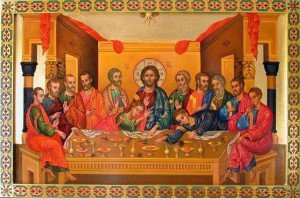The meaning of what is done in the Eucharist, the Divine Liturgy, is conveyed to the worshipper in the first place by the prayers which are said. This is one reason why I invented the Liturgical Scavenger Hunt. It is critical that we understand the words that we use in our communal prayer and truly make them our own words. But an understanding of the ritual we use can grow up alongside the prayers we use. As I have shared, a symbolic interpretation of the Liturgy was given as early as the third century. The first full-scale interpretation of the Liturgy in Constantinople was provided by Maximus the Confessor, one of the Eastern Fathers that all of my readers should know since I have included, over the past months, many of his thoughts in the articles of this Bulletin. His writings are from the first half of the seventh century. Prior to him, however, Dionysius the Areopagite gave an interpretation of the Liturgy. The writings of Dionysius, who was one of Paul’s converts in Athens, are generally held to belong to the late fifth or early sixty centuries and come from somewhere in Northern Syria. Their real author is unknown. It is possible that they come from a background not unfavorable to monophysitism, since they are first quoted in the works of the monophysite Severus, Patriarch of Antioch (512-18). (Monophysitism was condemned as a heresy. It maintained that Christ only had a divine nature and that He did not have a human nature. Chalcedon declared that Christ is fully God and man).
The Chalcedonians seem first to have heard these interpretations of the Liturgy in the course of theological conversations with Severian bishops in 532. Prior to that their attribution to Dionysius was generally assumed to be authentic. These writings, because of this attribution, carried considerable authority. Maximus made use of them and so did the last of the Byzantine liturgical commentators, Symeon of Thessalonike in the fifteenth century.
Dionysius’ interpretation of the Eucharist must be set in the context of his whole presentation of Christianity. He drew upon the Alexandrian theological tradition and on the philosophy of the Neoplatonists. The goal of the Christian life is union with God, whom Dionysius refers to as the One. He is the spiritual reality from whom all other spiritual realities have come and to whom they must return. Dionysius is not afraid to speak of man’s deification. But because of his disobedience man finds himself separated from God, separated from his fellows, and a prey to internal disruption. He is incapable by himself of rising above the passions which tear him apart and the material world which holds him down and prevents him from finding his lost immortality in union with God.

